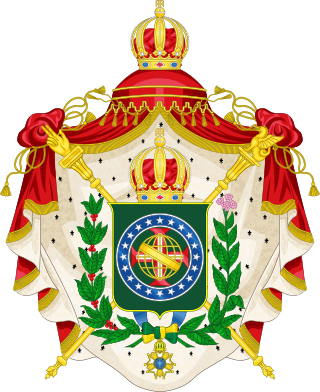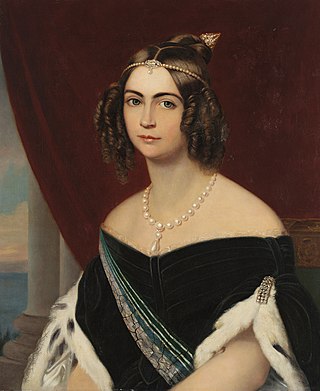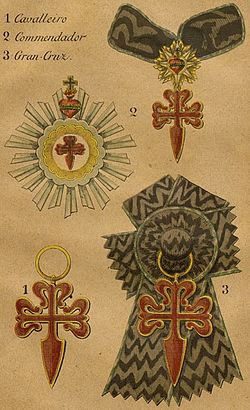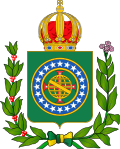
DomPedro I was the founder and first ruler of the Empire of Brazil, where he was known as "the Liberator". As King Dom Pedro IV, he reigned briefly over Portugal, where he also became known as "the Liberator" as well as "the Soldier King". Born in Lisbon, Pedro I was the fourth child of King Dom John VI of Portugal and Queen Carlota Joaquina, and thus a member of the House of Braganza. When the country was invaded by French troops in 1807, he and his family fled to Portugal's largest and wealthiest colony, Brazil.

Dona Maria II "the Educator" or "the Good Mother", was Queen of Portugal from 1826 to 1828, and again from 1834 to 1853.

The Most Serene House of Braganza, also known as the Brigantine dynasty, is a dynasty of emperors, kings, princes, and dukes of Portuguese origin which reigned in Europe and the Americas.

The coat of arms of Brazil was created on 19 November 1889, four days after Brazil became a republic. It consists of the central emblem surrounded by coffee and tobacco branches, which were important crops in Brazil at that time. In the round shield in the center, the Southern Cross can be seen. The ring of 27 stars around it represents Brazil's 26 states and the Federal District.

The Imperial House of Brazil is a Brazilian dynasty of Portuguese origin that ruled the Empire of Brazil from 1822 to 1889, after the proclamation of independence by Prince Pedro of Braganza who was later acclaimed as Pedro I, Constitutional Emperor and Perpetual Defender of Brazil. The members of the family are dynastic descendants of Emperor Pedro I. Claimants to headship of the post-monarchic Brazilian Imperial legacy descend from Emperor Pedro II, including the senior agnates of two branches of the House of Orléans-Braganza; the so-called Petrópolis and Vassouras lines. Prince Pedro Carlos of Orléans-Braganza heads the Petrópolis line, while the Vassouras branch is led by his second cousin, Bertrand of Orléans-Braganza.

Bertrand of Orléans-Braganza is the head of the Vassouras branch of the House of Orléans-Braganza and a claimant to the defunct Brazilian throne. He succeeded his brother Luiz of Orléans-Braganza to the claim on 15 July 2022. The Vassouras branch claims the throne in opposition to the Petrópolis branch of the Orléans-Braganzas, headed by Pedro Carlos Orléans-Braganza. Although Bertrand and Pedro Carlos respectively were and are great-grandchildren of Isabel, Princess Imperial, of the House of Braganza, their disputed leadership over the Brazilian Imperial Family is due to a dynastic dispute concerning their fathers, who were cousins.

Amélie of Leuchtenberg was Empress of Brazil as the wife of Pedro I of Brazil.

Prince August Leopold of Saxe-Coburg and Gotha, known in Brazil as Dom Augusto Leopoldo, was a prince of the Empire of Brazil and of the House of Saxe-Coburg and Gotha-Koháry. He was the second of four sons born to German Prince Ludwig August of Saxe-Coburg and Gotha and Princess Leopoldina of Brazil.

Pedro Luiz of Orléans-Bragança was the eldest son of Prince Antônio of Orléans-Braganza and Princess Christine de Ligne, being the grandson of Prince Pedro Henrique of Orléans-Braganza and Princess Maria Elisabeth of Bavaria.

The House of Orléans-Braganza is a cadet branch of the French House of Orléans and the name of the deposed Imperial House of Brazil formed from the marriage between Isabel, Princess Imperial of Brazil, of the House of Braganza, and Prince Gaston, Count of Eu, of the House of Orléans, in 1864. The House of Orléans-Braganza never reigned, as Brazil's pure Braganza monarch, Emperor Pedro II being deposed in a military coup d'état, under the pressure of the civilian republicans, in 1889. However, with the death of Isabel in 1921, as the last Brazilian pure Braganza, her descendants inherited the dynastic rights of the Brigantine dynasty over the defunct Brazilian throne.

Dona Paula was a princess of the Empire of Brazil and thus, a member of the Brazilian branch of the Portuguese House of Braganza. Her parents were Emperor Dom Pedro I, the first ruler of an independent Brazil, and Archduchess Leopoldina of Austria. Born in Rio de Janeiro, Paula was the couple's fifth child and third daughter child; she lost her mother at the age of three and her father at the age of eight, when he abdicated and left Brazil for Portugal, where he wanted to restore the throne of Paula's eldest sister, Maria da Glória, who should have become queen regnant of Portugal.

Dona Maria Amélia was a princess of the Empire of Brazil and a member of the Brazilian branch of the House of Braganza. Her parents were Emperor Dom Pedro I, the first ruler of Brazil, and Amélie of Leuchtenberg. The only child of her father's second marriage, Maria Amélia was born in France after Pedro I abdicated the Brazilian throne in favor of his son Dom Pedro II. Before Maria Amélia was a month old, Pedro I went to Portugal to restore the crown of the eldest daughter of his first marriage, Dona Maria II. He fought a successful war against his brother Miguel I, who had usurped Maria II's throne.

The Imperial Order of Our Lord Jesus Christ, simply named Order of Christ, is an order of chivalry instituted by emperor Pedro I of Brazil on 7 December 1822, on the basis of the Portuguese Order of Christ founded by King Dom Dinis and Pope John XXII in 1316–1319.

The Imperial Order of Dom Pedro I is a Brazilian order of chivalry instituted by Emperor Pedro I of Brazil on 16 April 1826. It is considered by many numismatists as the rarest of the Brazilian imperial orders.

The Imperial Order of the Rose was a Brazilian order of chivalry, instituted by Emperor Pedro I of Brazil on 17 October 1829 to commemorate his marriage to Amélie of Leuchtenberg.

Dom Afonso was the Prince Imperial and heir apparent to the throne of the Empire of Brazil. Born in Rio de Janeiro, he was the eldest child of Emperor Dom Pedro II and Dona Teresa Cristina of the Two Sicilies, and thus a member of the Brazilian branch of the House of Braganza.

Dom Pedro Afonso was the Prince Imperial and heir apparent to the throne of the Empire of Brazil. Born at the Palace of São Cristóvão in Rio de Janeiro, he was the second son and youngest child of Emperor Dom Pedro II and Dona Teresa Cristina of the Two Sicilies, and thus a member of the Brazilian branch of the House of Braganza. Pedro Afonso was seen as vital to the future viability of the monarchy, which had been put in jeopardy by the death of his older brother Dom Afonso almost three years earlier.

The Imperial Order of St. Benedict of Avis is an old Brazilian military order, originated from the Portuguese Military Order of Aviz, which in turn dates back to the medieval Order of Saint Benedict of Avis. This medieval order apparently originated in Spain from the Order of Calatrava; another theory reports that it originated in Portugal in the twelfth century under King Afonso Henriques.

Prince Peter August of Saxe-Coburg and Gotha, known in Brazil as Dom Pedro Augusto, was a prince of the Empire of Brazil and of the House of Saxe-Coburg and Gotha-Koháry. The favorite grandson of Emperor Pedro II, he was known as "the Preferred".

Luiz Gastão of Orléans-Braganza was the head of the Vassouras branch of the House of Orléans-Braganza and a claimant to the defunct Brazilian throne. The Vassouras branch claims the throne in opposition to the Petrópolis branch of the Orléans-Braganzas, headed by Pedro Carlos Orléans-Braganza. Although Luiz and Pedro Carlos respectively were and are great-grandchildren of Princess Isabel, of the House of Braganza, they disputed leadership over the Brazilian Imperial Family due to a dynastic dispute concerning their fathers, who were cousins.




















